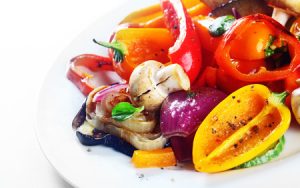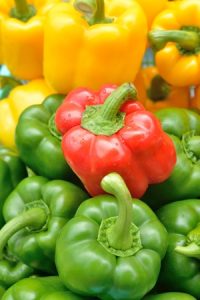The sweet pepper is really one of the easiest crops you can grow although it is only challenging if you don’t provide it with the conditions it loves. It is a near relative of the chilli but without the heat and produces very attractive large fruit in a glorious array of colours: purple, red, orange, yellow and green. They liven up any dish whether eaten fresh as in a seasonal salad or cooked in stir-fries, casseroles, tagines and infamous Mexican dishes like fajitas.

Think carefully though about what size you want as the large ones are ideal for stuffing whilst the other smaller ones are just cooked for their sweetness and as a side dish or starter.
It is not a straightforward crop in colder countries and for best results they need to be grown in the greenhouse or polytunnel. Nowadays, modern varieties offer some cold resistance but generally it has all been about yield and cropping size in the creation of new cultivars. Frost is a killer ! It is possible to grow sweet peppers outdoors in the UK and Northern Europe when any risk of frost has passed but I find they just don’t fruit well. Ensuring the conditions of light, heat, plenty of water and feed is essential for excellent growth.
Sowing Sweet Pepper Seeds
Pepper seeds need to be ideally started off in mid-January through to February although a reasonable yield can be generated from seed sown as late as early April. They are best sown in a propagator. In the later months, they do not really need a propagator to get the seed going. SimplySeed recommend using a heating mat if a propagator is not available. Again, make sure you protect them from any frost.
I sow seeds individually in cell trays with good quality compost. Sow the seeds on the surface of free-draining damp seed compost. Cover to about 1/4″ inch with a fine layer of compost or vermiculite. Water.
Place in a propagator or seal inside a polythene bag and keep a temperature of 20 to 25°C. The minimum can be 18 °C but expect lower germination rates.
Whilst the compost should not be allowed to dry our, peppers hate too much watering and will soon die. The seeds germinate between a week and two weeks.
Allow the seedlings to grow their two true leaves. Pot up the seedlings in 7.5cm pots and keep in a light, frost free area in the greenhouse (see the section on Growing On for the next steps).
Feed with a small amount of dilute high nitrogen fertiliser to encourage root and leaf growth. My preferred compost for potting on is John Innes No. 2 as multi-purpose compost can dry out just a bit too quickly.
Plugs
If you are buying sweet pepper plugs from the garden centre, get them in May because they will have formed decent sized plants. One of the most common stocked plants is cv. ‘Bell Boy’ which is very reliable. I check the root ball in the pot and repot immediately if I see a mass of exposed roots.

Growing On
Allow up to 4 true leaves to form on the main stem before repotting into a 9-12 cm (3.5-4 in.) pot with fresh compost.
Add some slow release fertiliser to encourage a consistent flow of nutrient to the roots. I carry on growing the pepper until the stem reaches 20 cm in length before final transfer to a larger pot. My ideal pot width is 20cm to 22cm (9 in.) and I like deep pots to allow strong roots to develop. Some growers recommend up to 30cm diameter pots but I can grow some of the grafted types in 50cm width pots for maximum root growth.
The alternative to a pot is a grow-bag and these also work outdoors too.
Maintain a temperature of 16 to 24°C at night and a maximum of 24°C during the day.
Between May and June keep checking for plants being pot-bound as growth at this time is very rapid. Simply move to bigger pots as time moves on.
Support the growth by fixing/staking the plant to a cane and continue feeding with slow growth fertiliser as fruits become heavy and have been known to break stems. Continue to grow in the warmest place possible.
Water continuously as they are highly demanding. Any drying out means growth stops and yields are reduced. Feeding is critical and a high potassium liquid tomato feed is excellent for good results. Once the first fruits have set, feed once a fortnight.
Growing Sweet Peppers Outdoors
If where you live is warm enough, sweet peppers can be grown outdoors. Acclimatize the plants to outdoor conditions for 7 to 10 days before planting in well drained soil and in a sunny sheltered spot.
Plant in rows, allowing 50cm between each plant.
Harvesting Your Sweet Peppers
The peppers need to achieve a suitable size before being picked. They will be ready between July and October although if no frost occurs, peppers have been picked outside in December if the area is frost-free. Check varieties as to their colour. Green ones are clearly picked before they ripen to either orange or red.
Problems
- Caterpillars can be a problem in greenhouses. The first noticeable sign are leaves with holes and specks of dirt and excrement on the leaves and fruit. I look under leaves almost daily and pick any off. These are late striking culprits so hopefully your fruit will have matured and been harvested by the time they appear.
- Look out for slugs and snails as they will munch through seedlings and plants. Use an animal-friendly slug pellet or a mug of beer (always think this is pure waste of beer though).
- Monitor for red spider mite and aphids.
- Look out for blossom end rot which affects a lot of soft fruit grown under glass. Ensure the plants are watered regularly to prevent this issue.
Sweet Pepper Varieties To Grow
cv. Ariane – a typical Sweet Pepper. Grows rapidly. It is a short-jointed variety with an ‘open plant habit’. Good sized fruits, said to have thick walls most fruits of which are 4-lobed. Harvested from green to deep orange which indicates its full maturity.
cv. Etiuda – a bright orange pepper which is rather beautiful especially when grown in the greenhouse or kitchen garden.
cv. New Ace is a sweet pepper variety that produces full bodied red fruits. Most growers prefer to pick them throughout their ripening period and the dark green form is highly attractive. Said to be thick walled. Has a good, sweet taste and ideal for cooking or salads.
cv. Sweet Banana is a variety of mildly sweet but 8 inch long peppers. They turn from a pale green to pale yellow. Claimed to be not as productive as their F1 varieties but enjoyable to grow all the same.
Leave a Reply